tow CADILLAC DEVILLE 1996 7.G User Guide
[x] Cancel search | Manufacturer: CADILLAC, Model Year: 1996, Model line: DEVILLE, Model: CADILLAC DEVILLE 1996 7.GPages: 354, PDF Size: 20.32 MB
Page 89 of 354
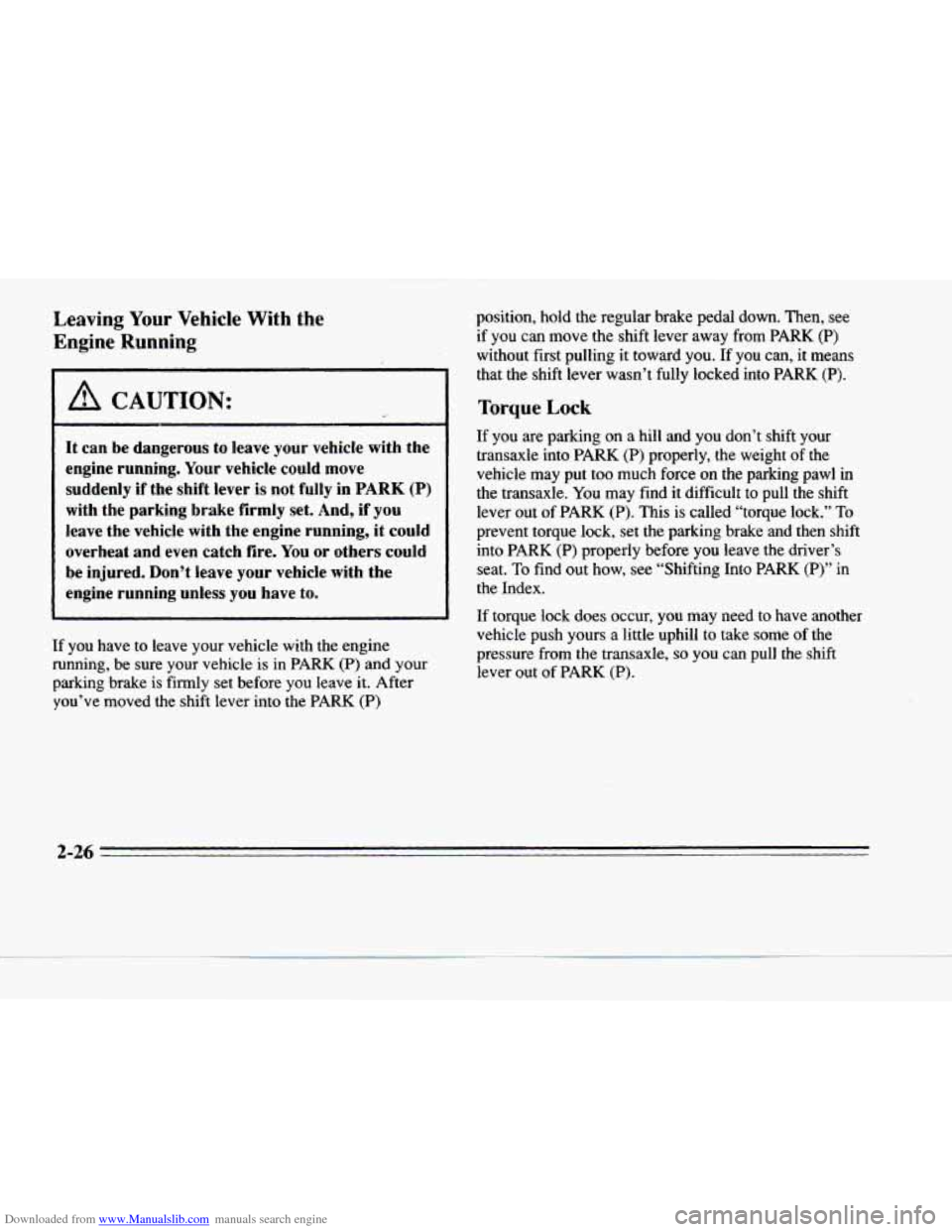
Downloaded from www.Manualslib.com manuals search engine Leaving Your Vehicle With the
Engine Running
I A CAUTION:
It can be dangerous to leave your vehicle with the
engine running. Your vehicle could move
suddenly if the shift lever
is not fully in PARK (P)
with the parking brake firmly set. And, if you
leave the vehicle with the engine running, it could
overheat and even catch fire.
You or others could
be injured. Don’t leave your vehicle with the
engine running unless
vou have to.
I
If you have to leave your vehicle with the engine
running, be sure your vehicle
is in PARK (P) and your
parking brake is firmly
set before you leave it. After
you’ve moved the shift lever into the PARK
(P)
position, hold the regular brake pedal down. Then, see
if you
can move the shift lever away from PARK (P)
without first pulling it toward you. If you can, it means
that the shift lever wasn’t fully locked into
PARK (P).
Torque Lock
If you are parking on a hill and you don’t shift your
transaxle into PARK
(P) properly, the weight of the
vehicle may put too much force on the parking pawl
in
the transaxle. You may find it difficult to pull the shift
lever out of
PARK (P). This is called “torque lock.” To
prevent torque lock, set the parking brake and then shift
into
PARK (P) properly before you leave the driver’s
seat.
To find out how, see “Shifting Into PARK (P)” in
the Index.
If torque lock does occur, you may need to have another
vehicle push yours a little uphill to take some
of the
pressure from the transaxle,
so you can pull the shift
lever out of PARK
(P).
2-26
r
Page 92 of 354
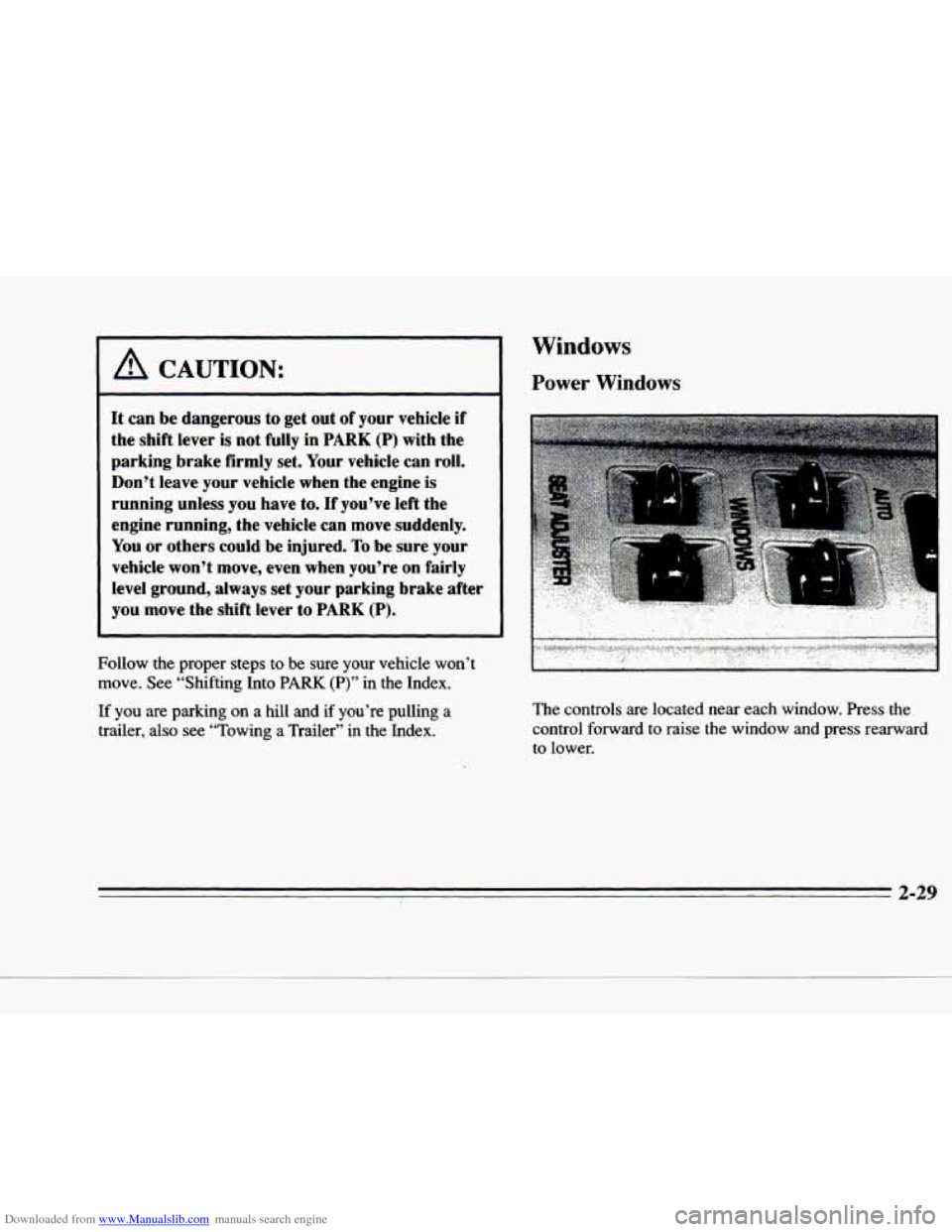
Downloaded from www.Manualslib.com manuals search engine p
I A CAUTION:
It can be dangerous to get out of your vehicle if
the shift lever is not fully in
PARK (P) with the
parking brake firmly set. Your vehicle
can roll,
Don’t leave your vehicle when the engine is
running unless you have to. If you’ve left the
engine running, the vehicle can move suddenly.
You or others could be injured, To be sure your
vehicle won’t move, even when you’re on
fairly
level ground, always set your parking brake after
you move
the shift lever to PARK (P).
c
Follow the proper steps to be sure your vehicle won’t
move. See “Shifting Into
PARK (P)” in the Index.
If
you are parking on a hill and if you’re pulling a
trailer, also see “Towing a Trailer” in the Index.
Windows
Power Windows
The controls are located near each window. Press the
control forward
to raise the window and press rearward
to lower.
c
Page 94 of 354
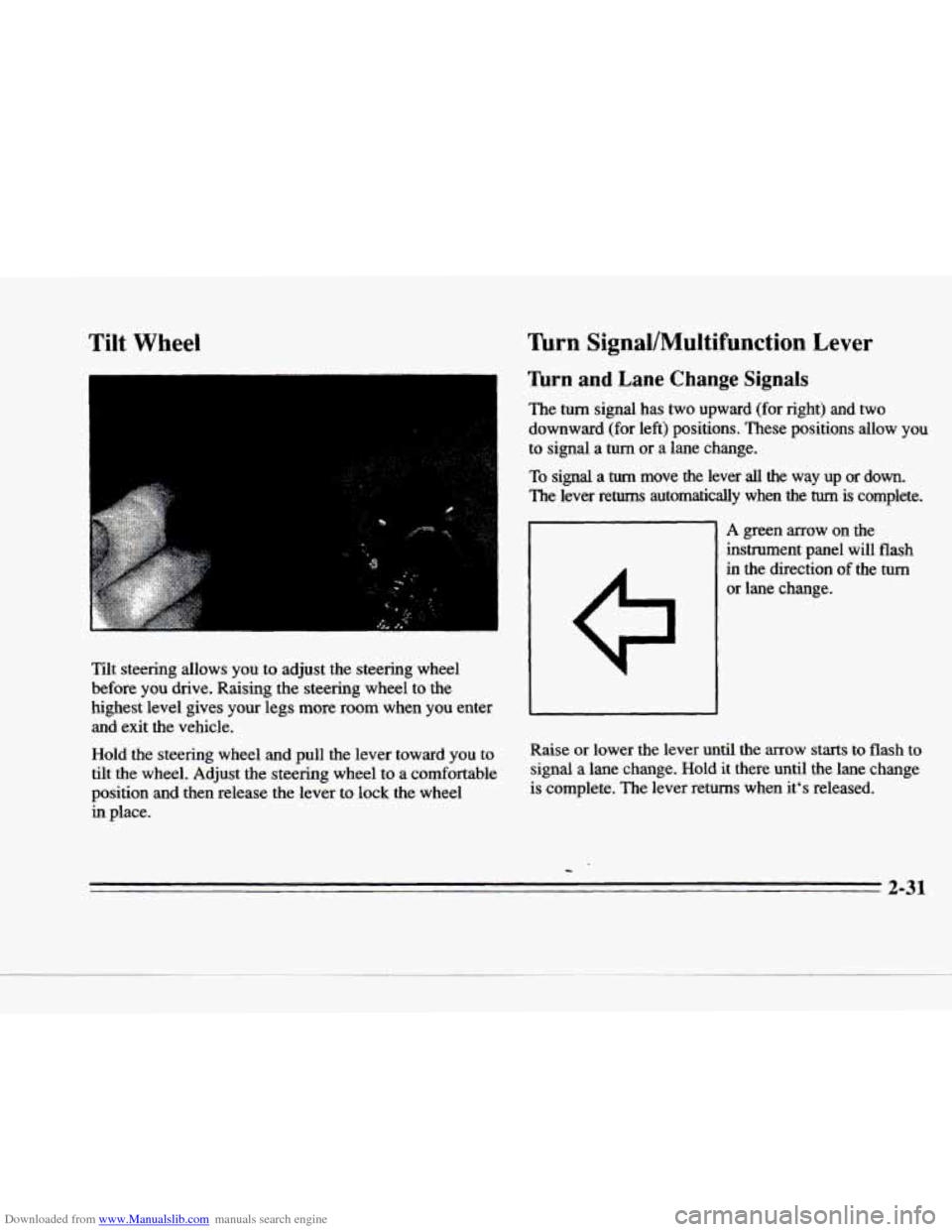
Downloaded from www.Manualslib.com manuals search engine Tilt Wheel
P
c
c
c
P
zit steering allows you to adjust the steering wheel
before you drive. Raising the steering wheel to the
highest level gives
your legs more room when you enter
and exit the vehicle.
Hold the steering wheel
and pull the lever toward you to
tilt the wheel. Adjust the steering wheel to a comfortable
position
and then release the lever to lock the wheel
in place.
Turn Signal/Multifunction Lever
lhrn and Lane Change Signals
The turn signal has two upward (for right) and two
downward (for left) positions.
These positions allow you
to signal a turn or a lane change.
To signal a turn move the lever all the way up or down.
The lever returns automatically when the turn is complete.
A green mow on the
instrument panel will
flash
in the direction of the turn
or lane change.
Raise or lower the lever until the
arrow starts to flash to
signal
a lane change. Hold it there until the lane change
is complete. The lever returns when it's released.
2-31
Page 95 of 354
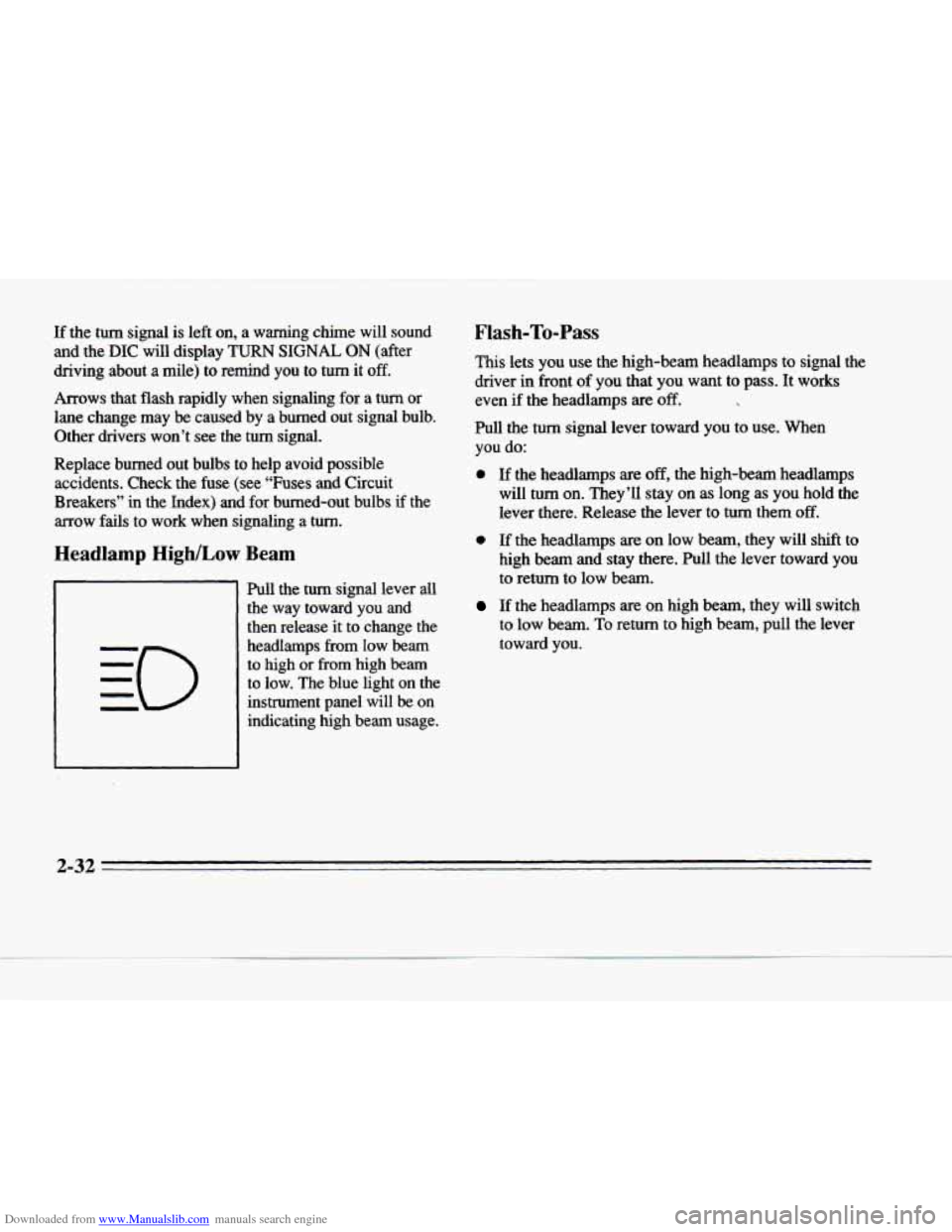
Downloaded from www.Manualslib.com manuals search engine If the turn signal is left on, a warning chime will sound
and the DIC
will display TURN SIGNAL ON (after
driving about
a mile) to remind you to turn it off.
Arrows that flash rapidly when signaling for a turn or
lane change may
be caused by a burned out signal bulb.
Other drivers won’t see the turn signal.
Replace burned out bulbs to help avoid possible accidents. Check the fuse (see “Fuses and Circuit
Breakers”
in the Index) and for burned-out bulbs if the
arrow fails to work when signaling a turn.
Headlamp High/Low Beam
Pull the turn signal lever all
the way toward you and then release
it to change the
headlamps
from low beam
to high
or from high beam
to low. The blue light on the
instrument panel will
be on
indicating high beam usage.
Flash-To-Pass
This lets you use the high-beam headlamps to signal the
driver in front
of you that you want to pass. It works
even
if the headlamps are ‘off.
Pull the turn signal lever toward you to use. When
you do:
0 If the headlamps are off, the high-beam headlamps
will turn
on. They’I1 stay on as long as you hold the
lever there. Release the lever to turn them
off.
0 If the headlamps are on low beam, they will shift to
high
beam and stay there. Pull the lever toward you
to return to low beam.
If the headlamps are on high beam, they will switch
to low beam. To return to high beam, pull the lever
toward you.
2-32
Page 96 of 354
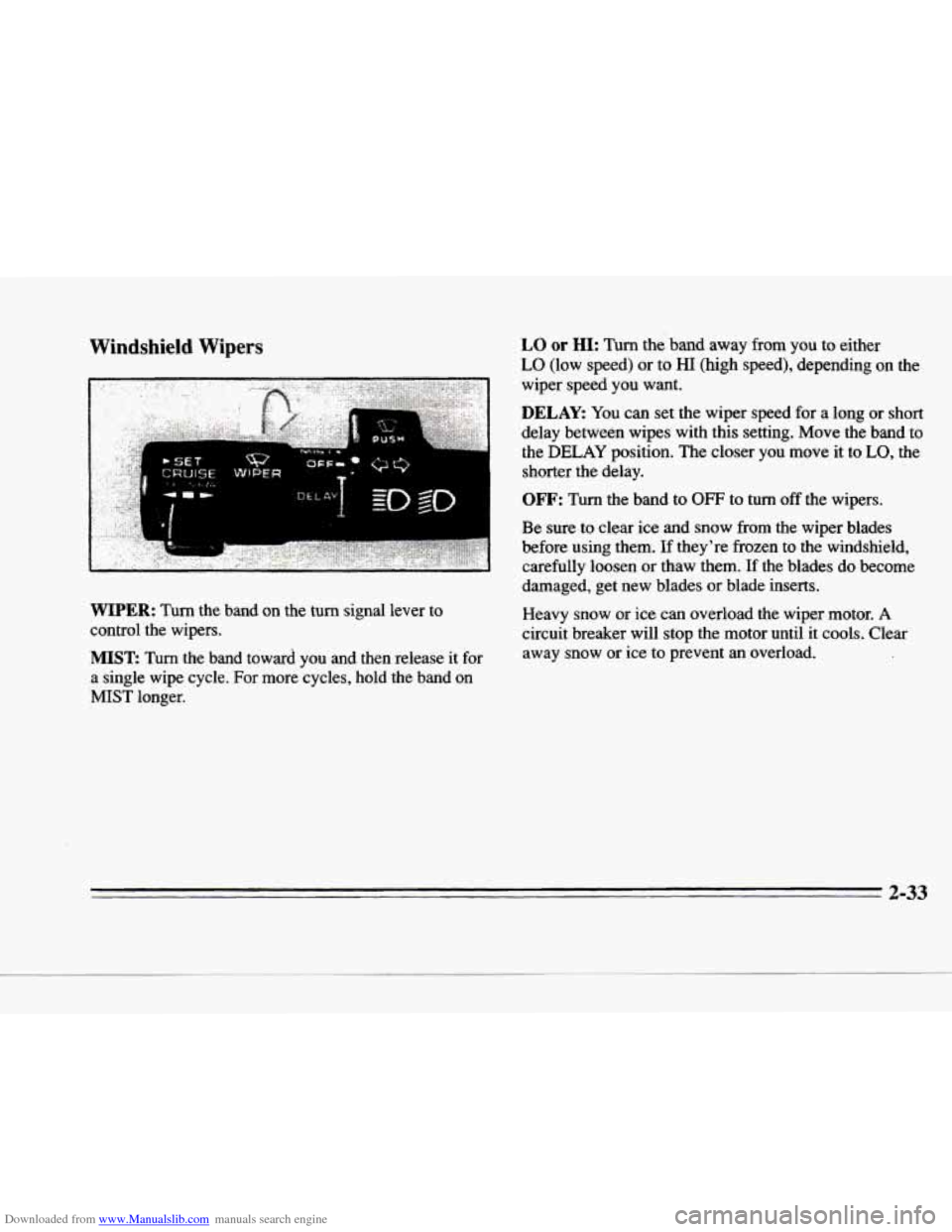
Downloaded from www.Manualslib.com manuals search engine c
c
e
c
Windshield WiDers
WIPER: Turn the band on the turn signal lever to
control the wipers.
MIST Turn the band toward you and then release it for
a single wipe cycle. For more cycles, hold the band on
MIST longer.
LO or HI: Turn the band away from you to either
LO (low speed) or to HI (high speed), depending on the
wiper speed
you want.
DELAY: You can set the wiper speed for a long or short
delay between wipes
with this setting. Move the band to
the
DELAY position. The closer you move it to LO, the
shorter the delay.
OFF: Turn the band to OFF to turn off the wipers.
Be sure to clear ice and snow from the wiper blades
before using them. If they’re frozen to the windshield,
carefully loosen
or thaw them. If the blades do become
damaged, get new blades
or blade inserts.
Heavy snow or ice can overload the wiper motor.
A
circuit breaker will stop the motor until it cools. Clear
away snow or ice to prevent
an overload.
2-33
Page 97 of 354
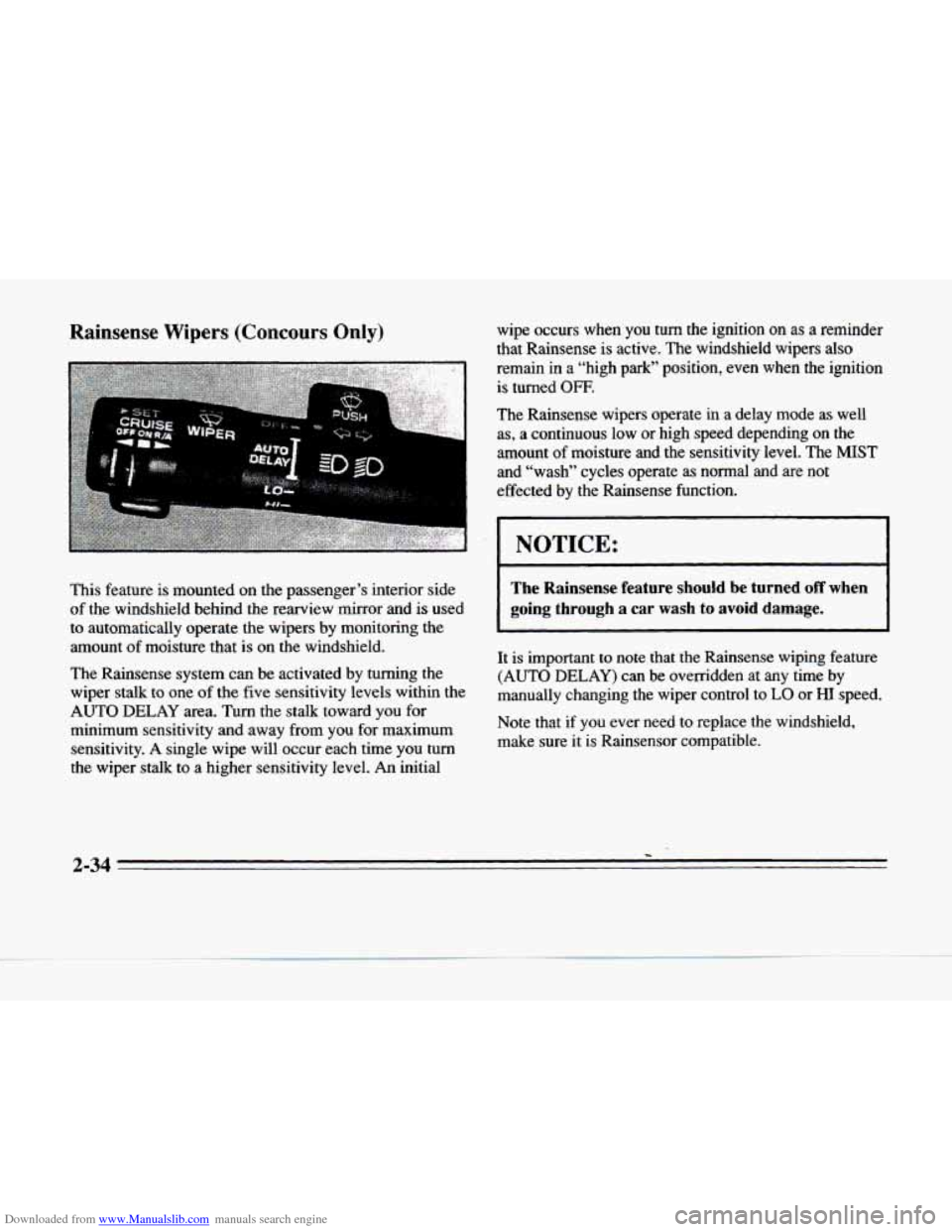
Downloaded from www.Manualslib.com manuals search engine This feature is mounted on the passenger’s interior side
of the windshield behind the rearview mirror and is used
to automatically operate the wipers by monitoring the
amount
of moisture that is on the windshield.
The Rainsense system can be activated by turning the
wiper stalk
to one of the five sensitivity levels within the
AUTO DELAY area. Turn the stalk toward you for
minimum sensitivity and away from you for maximum
sensitivity.
A single wipe will occur each time you turn
the wiper stalk to a higher sensitivity level.
An initial wipe occurs when
you turn the ignition on as a reminder
that Rainsense is active. The windshield wipers
also
remain in a “high park” position, even when the ignition
is turned
OFF.
The Rainsense wipers operate in a delay mode as well
as, a continuous low or high speed depending on the
amount
of moisture and the sensitivity level. The MIST
and “wash” cycles operate as normal and are not
effected by the Rainsense function.
NOTICE: I
- -- -~
The Rainsense feature should be turned off when
going through a car wash
to avoid damage.
It is important to note that the Rainsense wiping feature
(AUTO DELAY) can be overridden at any time
by
manually changing the wiper control to LO or HI speed.
Note that if you ever
need to replace the windshield,
make sure it is Rainsensor compatible.
2-34
-
Page 128 of 354
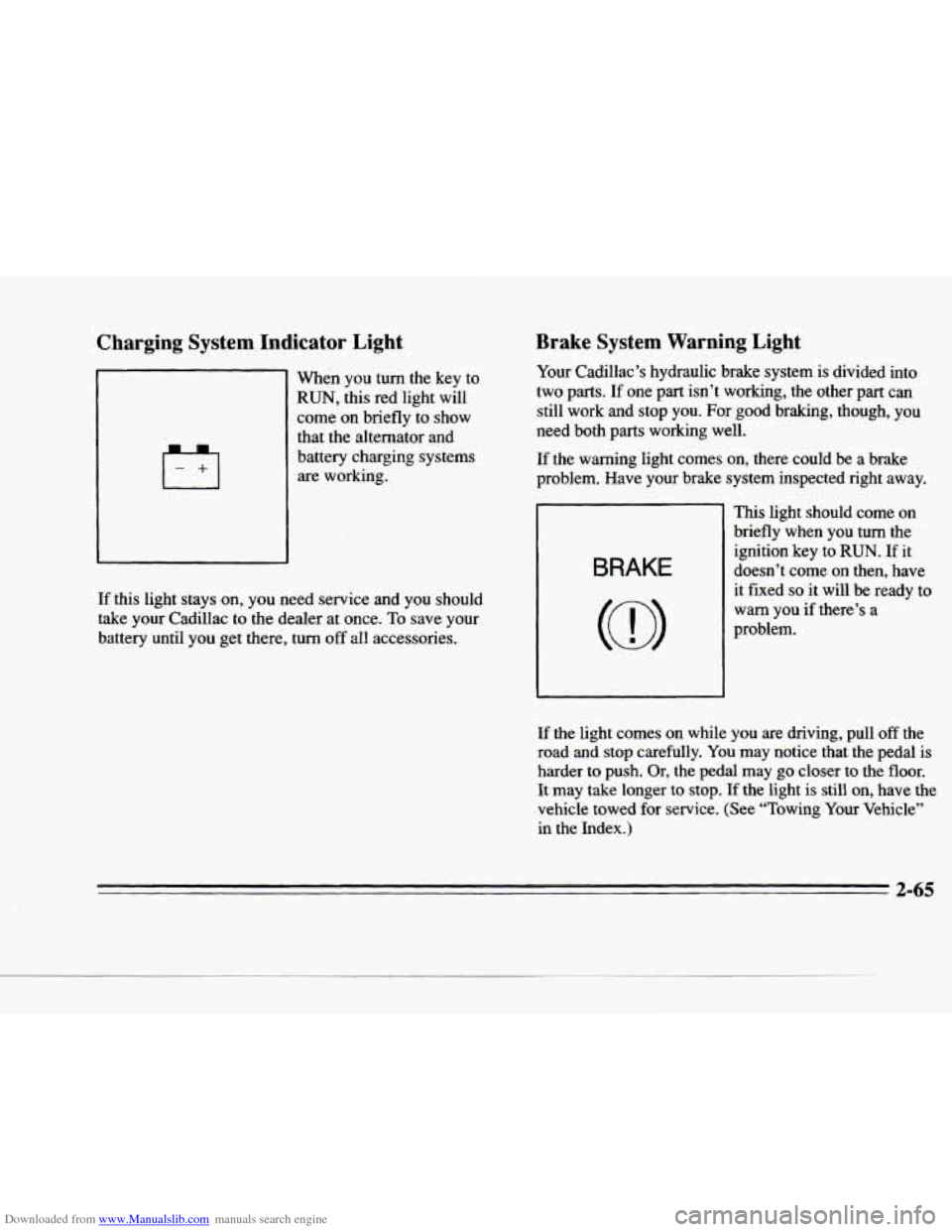
Downloaded from www.Manualslib.com manuals search engine P
P-
Charging System Indicator Light
I-el
When you turn the key to
RUN, this red light will
come
on briefly to show
that the alternator and
battery charging systems are working.
If this light stays on, you need service and you should
take your Cadillac
to the dealer at once. To save your
battery until you get there, turn off all accessories.
Brake System Warning Light
Your Cadillac’s hydraulic brake system is divided into
two parts. If one
part isn’t working, the other part can
still work and stop you. For good braking, though, you
need both parts working well.
If the warning light comes on, there could be a brake
problem. Have your brake system inspected right away.
BRAKE
This light should come on
briefly when you turn the
ignition key
to RUN. If it
doesn’t come on then, have it fixed
so it will be ready to
warn you
if there’s a
problem.
If
the light comes on while you are driving, pull off the
road and stop carefully.
You may notice that the pedal is
harder to push. Or, the pedal may
go closer to the floor.
It may take longer to stop. If the light is still on, have the
vehicle towed
for service. (See “Towing Your Vehicle”
in the Index.)
2-65
Page 129 of 354
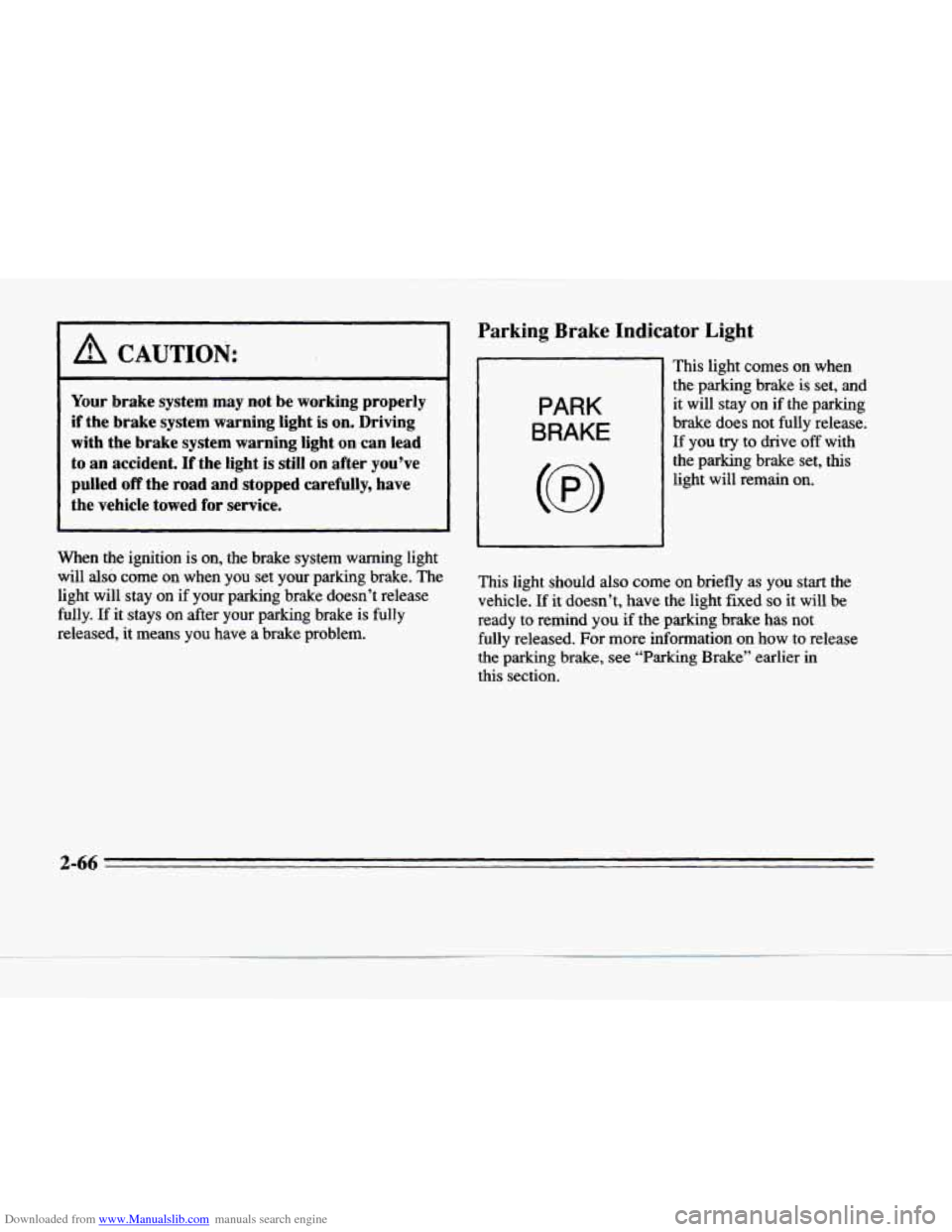
Downloaded from www.Manualslib.com manuals search engine I
I A CAUTION:
Your brake system may not be working properly if the brake system warning light is on. Driving
with the brake system warning light on can lead
to an accident.
If the light is still on after you’ve
pulled
off the road and stopped carefully, have
the vehicle towed for service.
-
When the ignition is on, the brake system warning light
will
also come on when you set your parking brake. The
light will stay on if your parking brake doesn’t release
fully. If it stays
on after your parking brake is fully
released, it means you have a brake problem.
Parking Brake Indicator Light
PARK
BRAKE
This light comes on when
the parking
brake is set, and
it will stay on if the parking
brake
does not fully release.
If you try to drive off with
the parking brake
set, this
light will remain on.
This light
should also come on briefly as you start the
vehicle. If
it doesn’t, have the light fixed so it will be
ready to remind
you if the parking brake has not
fully released. For more information
on how to release
the parking
brake, see “Parking Brake” earlier in
this section.
-.
2-66
Page 133 of 354
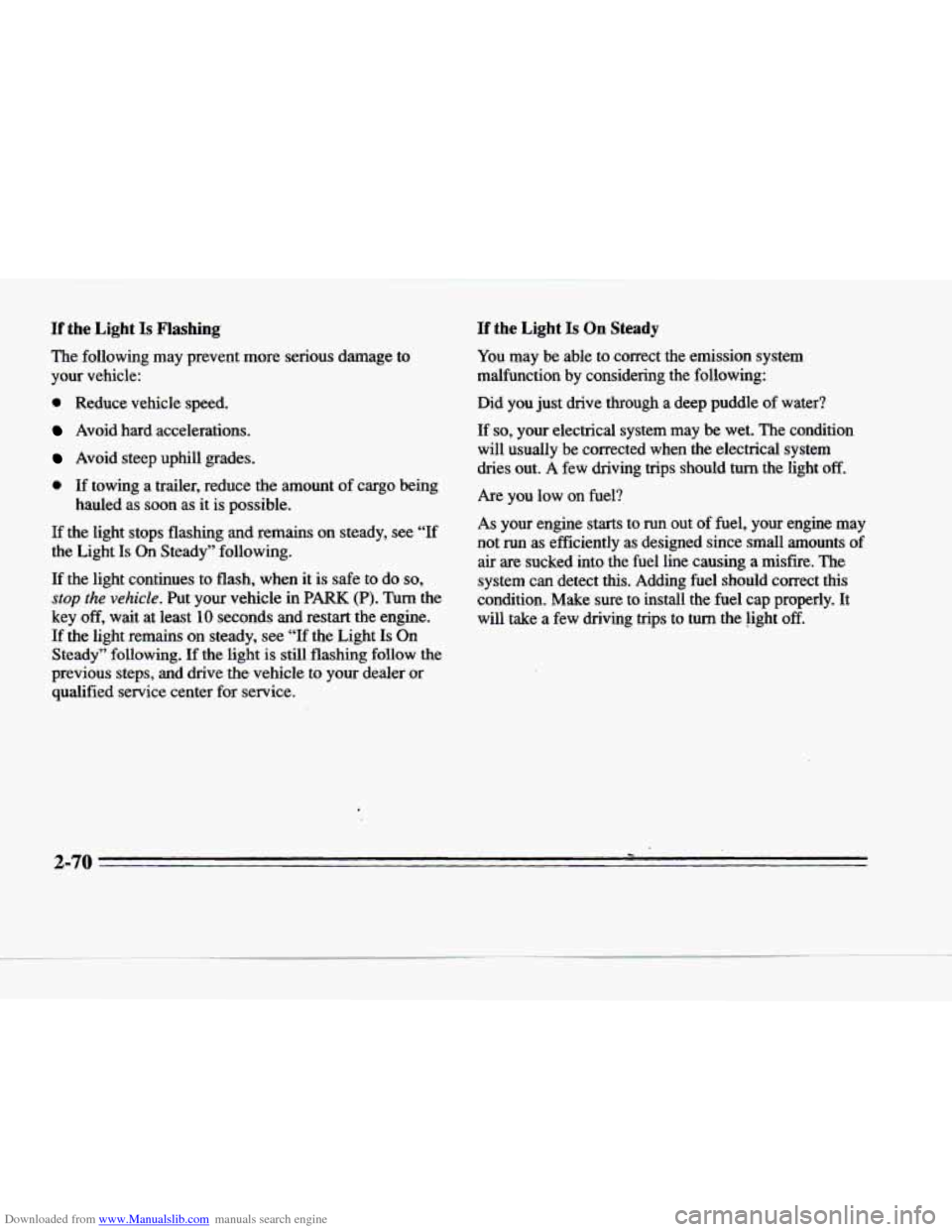
Downloaded from www.Manualslib.com manuals search engine If the Light Is Flashing’
The following may prevent more senous damage to
your vehicle:
If the Light Is On Steady
You may be able to correct the emission system
malfunction by considering the following:
e Reduce vehicle speed.
Avoid hard accelerations.
Avoid steep uphill grades.
0 If towing a trailer, reduce the amount of cargo being
hauled as soon as
it is possible. Did you
just drive through a deep puddle of water?
If
so, your electrical system may be wet. The condition
will usually be corrected when the electrical system
dries out.
A few driving trips should turn the light off.
Are you low on fuel?
As your engine starts to run out of fuel, your engine
may
not run as efficiently as designed since small amounts of
air are sucked into the fuel line causing a misfire. The
system can detect this. Adding fuel should correct this
condition.
Make sure to install the fuel cap properly. It
will take a few driving trips to
turn the light off.
If the light stops flashing and remains on steady, see “If
the Light Is On Steady” following.
If the light continues to flash, when
it is safe to do so,
stop the vehicle. FW your vehicle in PARK (P). Turn the
key off, wait at least
10 seconds and restart the engine.
If the light remains on steady, see “If the Light Is On
Steady” following.
If the light is still flashing follow the
previous steps, and drive
the vehicle to your dealer or
qualified service center for service.
2-70
-
Page 154 of 354
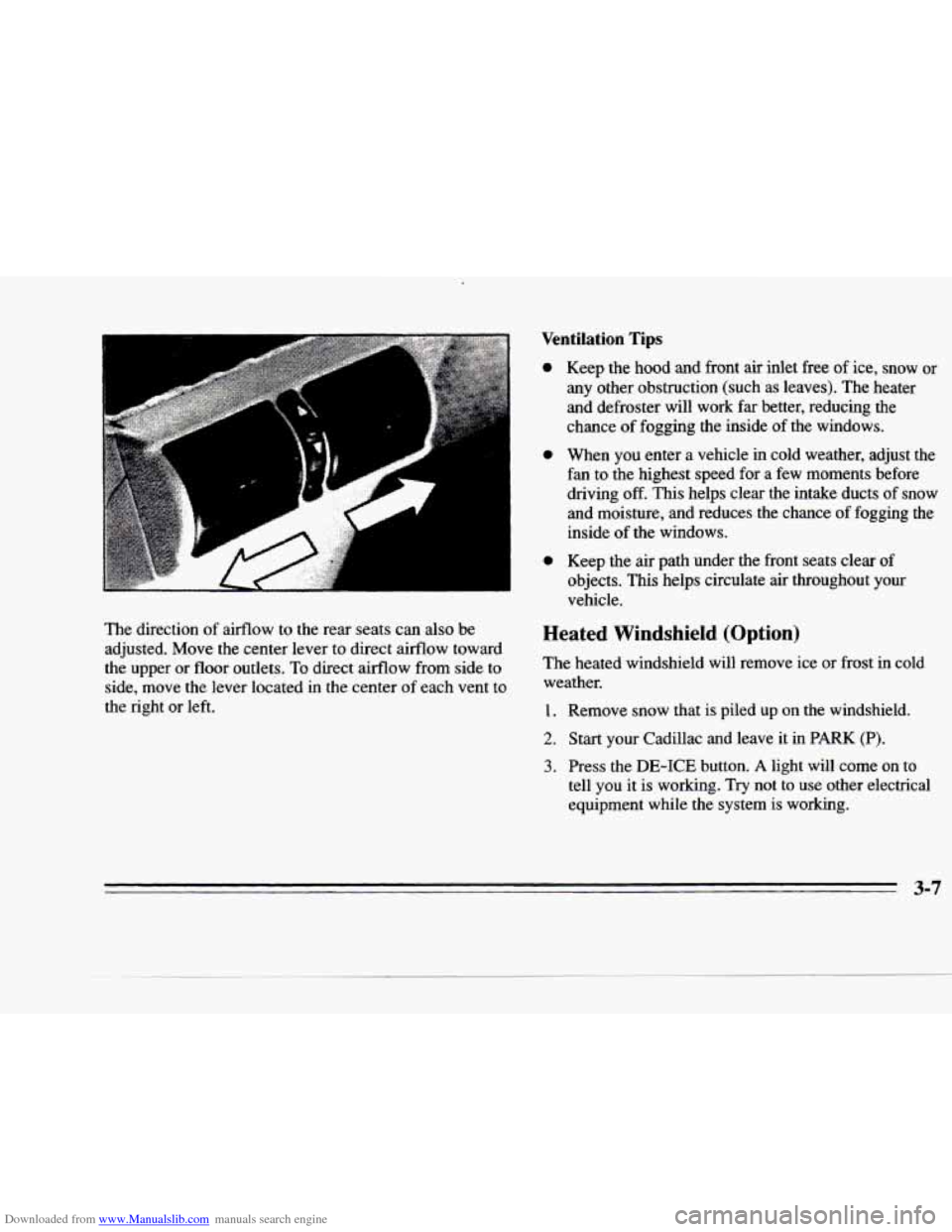
Downloaded from www.Manualslib.com manuals search engine Ventilation Tips
c
The direction of airflow to the rear seats can also be
adjusted. Move the center lever to direct airflow toward
the upper or floor outlets. To direct aifflow from side to
side, move the lever located in the center
of each vent to
the right or left.
e Keep the hood and front air inlet free of ice, snow or
any other obstruction (such as leaves). The heater
and defroster will work
far better, reducing the
chance
of fogging the inside of the windows.
When you enter a vehicle in cold weather, adjust the
fan to the highest speed for a few moments before
driving
off. This helps clear the intake ducts of snow
and moisture, and reduces the chance of fogging the
inside
of the windows.
Keep the air path under the front seats clear
of
objects. This helps circulate air throughout your
vehicle.
Heated Windshield (Option)
The heated windshield will remove ice or frost in cold
weather.
1. Remove snow that is piled up on the windshield.
2. Start your Cadillac and leave it in PARK (P).
3. Press the DE-ICE button. A light will come on to
tell
you it is working. Try not to use other electrical
equipment while the system is working.
3-7